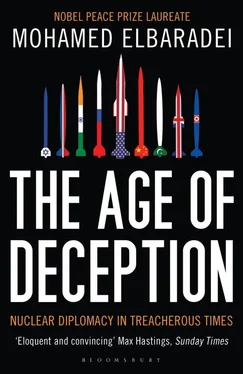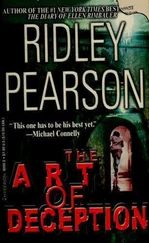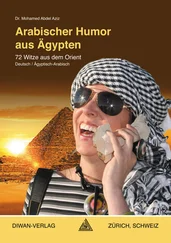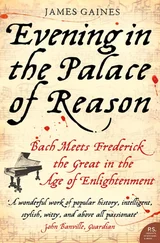It was time to confront the Iranians. On October 16, I headed back to Tehran, this time to meet with Hassan Rowhani, the secretary of Iran’s National Security Council. The encounter was pivotal. After the requisite exchange of pleasantries, I laid out a series of substantive issues—centrifuge testing, laser isotope separation, uranium conversion, the heavy water reactor project, and the IAEA’s sample results—in unambiguous terms. The pattern of deception and backtracking, I told him, could not go on.
Rowhani came to the meeting prepared. Without directly apologizing for past concealment and deception, he said that Iran was ready to turn over a new leaf in its relationship with the Agency. The Iranian leadership, he said, had agreed to provide the Agency with a full disclosure of Iran’s past and present nuclear activities in the course of the following week. Iran was also ready to conclude an Additional Protocol, and pending its entry into force, to act in accordance with the protocol’s provisions allowing the Agency wide-ranging inspection access.
Behind the scenes, Rowhani had been negotiating on Iran’s behalf with the foreign ministers of France, Germany, and the United Kingdom (the EU-3). On October 21, the four governments issued a statement they would refer to as the Tehran Declaration, which reaffirmed the basic pledges Rowhani had made to me days earlier regarding Iran’s intent to cooperate with the IAEA and to implement an Additional Protocol. The declaration also announced Iran’s agreement to suspend its enrichment and reprocessing activities during the course of ongoing negotiations with the EU-3 as a confidence-building measure. In return, the EU-3 agreed to recognize Iran’s nuclear rights and to outline specific ways for Iran to provide “objective guarantees” about the peaceful nature of its nuclear program. Once those assurances were provided, the EU-3 would provide Iran access to modern technology, including nuclear technology.
Two days later, the IAEA received a letter from Aghazadeh declaring that Iran was “commencing a new phase of confidence and co-operation.” The letter admitted to many activities Iran had previously denied, and it augmented our picture of Iran’s nuclear program with significant new information. It turned out that Iran had tested centrifuges with nuclear material at Kalaye using the UF 6gas that had been “missing” from one of the cylinders at the JHL. It had experimented with laser enrichment throughout the 1990s. It had conducted reprocessing experiments at the Tehran Nuclear Research Center and separated a small amount of plutonium. Additional nuclear material, previously unreported, had been used in extensive uranium conversion experiments. None of these activities pointed explicitly toward a nuclear weapons program, but together they constituted a fairly comprehensive nuclear fuel cycle program, most of it conducted in secret.
On November 10, 2003, I submitted my report to the IAEA Board of Governors. It was detailed and thorough; there was a great deal to convey. I outlined Iran’s numerous failures, over an extended period of time, to declare nuclear material and facilities to the IAEA. I characterized Iran’s behavior during the recent inspections as following a “policy of concealment” and providing “limited” and “reactive” cooperation. On the other hand, I gave Iran credit for its promise to shift to “full cooperation” with the Agency, its subsequent moves toward transparency, its willingness to suspend enrichment and reprocessing operations, and its decision to sign and implement an Additional Protocol.
None of this would prove controversial. But near the end of the report, I included the IAEA’s interim judgment about Iran in terms of nuclear weapons proliferation: “To date,” I wrote, “there is no evidence that the previously undeclared nuclear material and activities referred to above were related to a nuclear weapons programme. However, given Iran’s past pattern of concealment, it will take some time before the Agency is able to conclude that Iran’s nuclear programme is exclusively for peaceful purposes.”
It was a factual statement, dispassionate and straightforward. But it drew a sharp reaction. John Bolton, the U.S. undersecretary of state for arms control and international security, was furious that the IAEA had not taken a more hard-line position against Iran. A pointless dispute emerged in diplomatic back corridors over the legal meaning of the term evidence as used in the IAEA report. Bolton engineered a harsh rebuttal. The American ambassador to the IAEA, Ken Brill, was ordered to read a statement claiming that “the institution charged by the international community with scrutinizing nuclear proliferation risks is dismissing important facts that have been disclosed by its own investigation.” It would take time, the statement said, “to overcome the damage caused to the Agency’s credibility.”
Brill was gracious enough to share an advance copy of the statement with me. Even so, I was incensed when it was read aloud to the Board. I asked the chairman for the floor and answered on the spot, without a prepared text, defending the integrity of the Agency and its inspectors. I drew attention to the enormous progress we had made in developing a picture of Iran’s nuclear program—more progress in ten months than the world’s best intelligence agencies had come up with in the previous ten years. And I issued a fierce refutation of the Americans’ obsessive—and logically incorrect—focus on what they called the “evidence” of Iran’s nuclear weapons intentions. My Blackstone Legal Dictionary from my New York University Law School days thirty years earlier was once again pressed into service.
“Frankly,” I declared, “I find it disingenuous that this word, evidence, has suddenly become a matter of contention. In fact, the credibility of the Agency has increased since Iraq, because of our objectivity.” My reference was clear: if anyone had lost credibility over their careless use of the term evidence, it was the Americans and their allies in their catastrophic rush to war in Iraq. We were seeing daily evidence in Iraq of the consequences of U.S. and U.K. eagerness to promote unverified intelligence as evidence. To attack the IAEA for its adherence to facts was brazenly hypocritical.
The boardroom was hushed. People were stunned at this public exchange between the Americans and the IAEA Director General in a diplomatic setting. I had remained seated; I had not raised my voice; but the directness of my remarks had been unmistakable. As the Board chairman moved on to recognize the next speaker, I realized I needed to leave the boardroom to regain my composure. A number of delegations told me after the meeting that this had been a “historic day” to see an international civil servant stand up to bullying by the United States.
Soon after the public disclosure of Iran’s undeclared activities, I wrote a piece for the Economist calling for operation of the nuclear fuel cycle under joint multinational control. This was not a new idea; internationally operated fuel cycles had been the topic of studies and committees as far back as the mid-1970s. Even U.S. president Eisenhower’s original “Atoms for Peace” speech in 1953 had hinted at such a goal.
But with nuclear technology and know-how spreading rapidly, through means both legitimate and clandestine, there was a new urgency. If each country were to develop its own fuel cycle, it would open a Pandora’s box of proliferation risks. Taking a multinational approach—building centralized fuel cycle facilities under the auspices of multiple countries, for the use of all participants—might put the lid back on the box. Legitimate users of nuclear energy would be assured of a reliable fuel supply for their reactors. The economic advantages were considerable: eliminating the need for hugely expensive, country-specific factories for uranium enrichment and plutonium production. Most important, the risk of nuclear material being diverted to nuclear weapons would plummet.
Читать дальше












